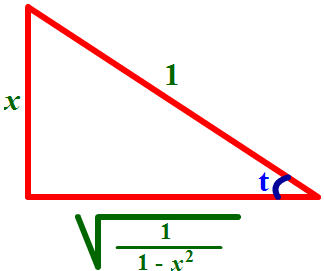4.7: Inverse Trigonometric Derivatives
- Page ID
- 529
\( \newcommand{\vecs}[1]{\overset { \scriptstyle \rightharpoonup} {\mathbf{#1}} } \)
\( \newcommand{\vecd}[1]{\overset{-\!-\!\rightharpoonup}{\vphantom{a}\smash {#1}}} \)
\( \newcommand{\dsum}{\displaystyle\sum\limits} \)
\( \newcommand{\dint}{\displaystyle\int\limits} \)
\( \newcommand{\dlim}{\displaystyle\lim\limits} \)
\( \newcommand{\id}{\mathrm{id}}\) \( \newcommand{\Span}{\mathrm{span}}\)
( \newcommand{\kernel}{\mathrm{null}\,}\) \( \newcommand{\range}{\mathrm{range}\,}\)
\( \newcommand{\RealPart}{\mathrm{Re}}\) \( \newcommand{\ImaginaryPart}{\mathrm{Im}}\)
\( \newcommand{\Argument}{\mathrm{Arg}}\) \( \newcommand{\norm}[1]{\| #1 \|}\)
\( \newcommand{\inner}[2]{\langle #1, #2 \rangle}\)
\( \newcommand{\Span}{\mathrm{span}}\)
\( \newcommand{\id}{\mathrm{id}}\)
\( \newcommand{\Span}{\mathrm{span}}\)
\( \newcommand{\kernel}{\mathrm{null}\,}\)
\( \newcommand{\range}{\mathrm{range}\,}\)
\( \newcommand{\RealPart}{\mathrm{Re}}\)
\( \newcommand{\ImaginaryPart}{\mathrm{Im}}\)
\( \newcommand{\Argument}{\mathrm{Arg}}\)
\( \newcommand{\norm}[1]{\| #1 \|}\)
\( \newcommand{\inner}[2]{\langle #1, #2 \rangle}\)
\( \newcommand{\Span}{\mathrm{span}}\) \( \newcommand{\AA}{\unicode[.8,0]{x212B}}\)
\( \newcommand{\vectorA}[1]{\vec{#1}} % arrow\)
\( \newcommand{\vectorAt}[1]{\vec{\text{#1}}} % arrow\)
\( \newcommand{\vectorB}[1]{\overset { \scriptstyle \rightharpoonup} {\mathbf{#1}} } \)
\( \newcommand{\vectorC}[1]{\textbf{#1}} \)
\( \newcommand{\vectorD}[1]{\overrightarrow{#1}} \)
\( \newcommand{\vectorDt}[1]{\overrightarrow{\text{#1}}} \)
\( \newcommand{\vectE}[1]{\overset{-\!-\!\rightharpoonup}{\vphantom{a}\smash{\mathbf {#1}}}} \)
\( \newcommand{\vecs}[1]{\overset { \scriptstyle \rightharpoonup} {\mathbf{#1}} } \)
\( \newcommand{\vecd}[1]{\overset{-\!-\!\rightharpoonup}{\vphantom{a}\smash {#1}}} \)
\(\newcommand{\avec}{\mathbf a}\) \(\newcommand{\bvec}{\mathbf b}\) \(\newcommand{\cvec}{\mathbf c}\) \(\newcommand{\dvec}{\mathbf d}\) \(\newcommand{\dtil}{\widetilde{\mathbf d}}\) \(\newcommand{\evec}{\mathbf e}\) \(\newcommand{\fvec}{\mathbf f}\) \(\newcommand{\nvec}{\mathbf n}\) \(\newcommand{\pvec}{\mathbf p}\) \(\newcommand{\qvec}{\mathbf q}\) \(\newcommand{\svec}{\mathbf s}\) \(\newcommand{\tvec}{\mathbf t}\) \(\newcommand{\uvec}{\mathbf u}\) \(\newcommand{\vvec}{\mathbf v}\) \(\newcommand{\wvec}{\mathbf w}\) \(\newcommand{\xvec}{\mathbf x}\) \(\newcommand{\yvec}{\mathbf y}\) \(\newcommand{\zvec}{\mathbf z}\) \(\newcommand{\rvec}{\mathbf r}\) \(\newcommand{\mvec}{\mathbf m}\) \(\newcommand{\zerovec}{\mathbf 0}\) \(\newcommand{\onevec}{\mathbf 1}\) \(\newcommand{\real}{\mathbb R}\) \(\newcommand{\twovec}[2]{\left[\begin{array}{r}#1 \\ #2 \end{array}\right]}\) \(\newcommand{\ctwovec}[2]{\left[\begin{array}{c}#1 \\ #2 \end{array}\right]}\) \(\newcommand{\threevec}[3]{\left[\begin{array}{r}#1 \\ #2 \\ #3 \end{array}\right]}\) \(\newcommand{\cthreevec}[3]{\left[\begin{array}{c}#1 \\ #2 \\ #3 \end{array}\right]}\) \(\newcommand{\fourvec}[4]{\left[\begin{array}{r}#1 \\ #2 \\ #3 \\ #4 \end{array}\right]}\) \(\newcommand{\cfourvec}[4]{\left[\begin{array}{c}#1 \\ #2 \\ #3 \\ #4 \end{array}\right]}\) \(\newcommand{\fivevec}[5]{\left[\begin{array}{r}#1 \\ #2 \\ #3 \\ #4 \\ #5 \\ \end{array}\right]}\) \(\newcommand{\cfivevec}[5]{\left[\begin{array}{c}#1 \\ #2 \\ #3 \\ #4 \\ #5 \\ \end{array}\right]}\) \(\newcommand{\mattwo}[4]{\left[\begin{array}{rr}#1 \amp #2 \\ #3 \amp #4 \\ \end{array}\right]}\) \(\newcommand{\laspan}[1]{\text{Span}\{#1\}}\) \(\newcommand{\bcal}{\cal B}\) \(\newcommand{\ccal}{\cal C}\) \(\newcommand{\scal}{\cal S}\) \(\newcommand{\wcal}{\cal W}\) \(\newcommand{\ecal}{\cal E}\) \(\newcommand{\coords}[2]{\left\{#1\right\}_{#2}}\) \(\newcommand{\gray}[1]{\color{gray}{#1}}\) \(\newcommand{\lgray}[1]{\color{lightgray}{#1}}\) \(\newcommand{\rank}{\operatorname{rank}}\) \(\newcommand{\row}{\text{Row}}\) \(\newcommand{\col}{\text{Col}}\) \(\renewcommand{\row}{\text{Row}}\) \(\newcommand{\nul}{\text{Nul}}\) \(\newcommand{\var}{\text{Var}}\) \(\newcommand{\corr}{\text{corr}}\) \(\newcommand{\len}[1]{\left|#1\right|}\) \(\newcommand{\bbar}{\overline{\bvec}}\) \(\newcommand{\bhat}{\widehat{\bvec}}\) \(\newcommand{\bperp}{\bvec^\perp}\) \(\newcommand{\xhat}{\widehat{\xvec}}\) \(\newcommand{\vhat}{\widehat{\vvec}}\) \(\newcommand{\uhat}{\widehat{\uvec}}\) \(\newcommand{\what}{\widehat{\wvec}}\) \(\newcommand{\Sighat}{\widehat{\Sigma}}\) \(\newcommand{\lt}{<}\) \(\newcommand{\gt}{>}\) \(\newcommand{\amp}{&}\) \(\definecolor{fillinmathshade}{gray}{0.9}\)Definition of the Inverse Trig Functions
Recall that we write \( \sin^{-1} x\) or \(\text{arcsin}\, x\) to mean the inverse \(\sin\) of \(x\) restricted to have values between \(-\pi/2\) and \(\pi/2\) (Note that \(\sin x\) does not pass the horizontal line test, hence we need to restrict the domain.) We define the other five inverse trigonometric functions similarly.
Inverse of Arctrig Functions
Find \(\tan(\sin^{-1} x)\)
Solution
\[\tan(\sin^{-1} x) = \dfrac{x}{\sqrt{1-x^2}}.\nonumber \]

The triangle above demonstrates that
\[\sin t = \dfrac{x}{1} = \dfrac{opp}{hyp}.\nonumber \]
Hence
\[ \tan(\tan^{-1} x) = \dfrac{x}{\sqrt{1-x^2}}.\nonumber \]
Since the
\[ \text{tangent} = \dfrac{opp}{adj}.\nonumber \]
We have
\[ \tan ( \sin^{-1} x) = \dfrac{x}{\sqrt{1-x^2}}.\nonumber \]
Simplify
\[ \cos(\tan^{-1} (2x)).\nonumber \]
Derivatives of the Arctrigonometric Functions
Recall that if \(f\) and \(g\) are inverses, then
\[ g'(x) \dfrac{1}{f'(g(x))}.\nonumber \]
What is
\[ \dfrac{d}{dx} \tan^{-1} x\text{?}\nonumber \]
We use the formula:
\[\frac{d}{dx} \tan^{-1} x= \dfrac{1}{\sec^2 (\tan^{-1} x)} = \cos^2 (\tan^{-1} x).\nonumber \]
Since
\[ \tan q = \dfrac{opp}{adj} = \dfrac{x}{1} \nonumber \]
we have
\[ hyp = \sqrt{1+x^2}\nonumber \]
so that
\[ \cos^2 (\tan^{-1} x) = \left( \dfrac{1}{\sqrt{1+x^2}}\right)^2 = \dfrac{1}{1+x^2}.\nonumber \]
Relationships
\[ \dfrac{d}{dx} \tan^{-1} x = \dfrac{1}{1+x^2} \nonumber \]
\[ \dfrac{d}{dx} \sin^{-1} x = \dfrac{1}{\sqrt{1-x^2}} \nonumber \]
\[ \dfrac{d}{dx} \sec^{-1} x = \dfrac{1}{|x|\sqrt{x^2-1|}} \nonumber \]
Recall that
\[ \cos x = \sin \left(\dfrac{\pi}{2} - x \right) \nonumber \]
hence
\[ \cos^{-1} x = \dfrac{\pi}{2} - \sin^{-1} x\nonumber \]
so
\[ \dfrac{d}{dx} \cos^{-1} x = \dfrac{d}{dx} \left[ \dfrac{\pi}{2} - \sin^{-1} x \right] \nonumber \]
\[ = \dfrac{-d}{dx} \sin^{-1} x = \dfrac{-1}{\sqrt{1-x^2}}.\nonumber \]
Similarly:
\[\dfrac{d}{dx} \cot^{-1} x = \dfrac{-1}{\sqrt{1 + x^2}} \nonumber \]
\[\dfrac{d}{dx} \text{csc}\, x\ = \dfrac{-1}{\sqrt{1-x^2}}. \nonumber \]
Find the derivative of \( \cos(\sin^{-1} x)\).
Solution
Let \(y = \cos u\), \(u = \sin^{-1} x\), and \(y' = -\sin u\)
\[ y'u= -\sin (\sin^{-1} x) = x\nonumber \]
\[ u' = \dfrac{1}{\sqrt{1-x^2}}.\nonumber \]
We arrive at
\[ \dfrac{dy}{dx} = \dfrac{x}{\sqrt{1-x^2}}.\nonumber \]
Contributors and Attributions
- Larry Green (Lake Tahoe Community College)
Integrated by Justin Marshall.


